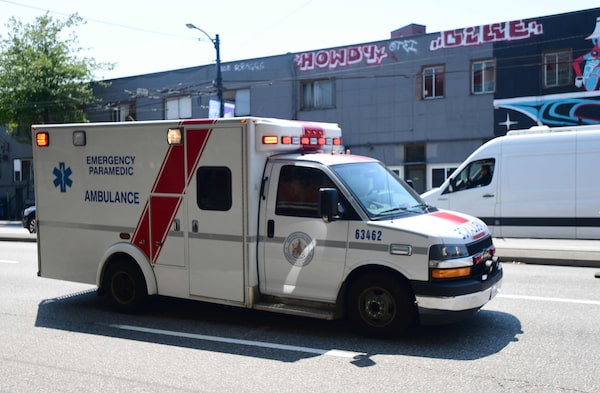
A broad statistical analysis indicates that more deaths occurred in areas with lower incomes, more people living alone, and less green space.DON MACKINNON/AFP/Getty Images
The June heat wave that killed hundreds of people in B.C. was the most deadly weather event in Canadian history by a factor of about three, a scientific director from the B.C. Centre for Disease Control says.
The only other weather catastrophe that came close was the 2010 heat wave in Montreal, said Sarah Henderson, who is in the centre’s environmental health services division. She was presenting a new set of analytical statistics at a meeting of B.C.’s municipal politicians about the deaths currently being attributed to the heat wave. During that week in June, almost 600 more deaths occurred than would be normal for the period.
And she and Provincial Health Officer Bonnie Henry warned that this kind of “one in 1,000 year” disaster is likely to happen again soon because of climate change.
Among those hardest hit were people living in their homes, not those in hospitals or long-term care. The rate of deaths at home tripled in the last week of June when temperatures in the usually moderate coastal areas soared to as high as 40 degrees.
“A lot of people lost their lives in private residences,” Dr. Henderson said. “This is likely due to to extremely high indoor temperatures in homes without air conditioning.”
Deaths in care homes and hospitals were 30 and 35 per cent higher than the normal rate, respectively, compared to the 205 per cent increase in communities, mainly in apartments, houses and mobile homes.
A broad statistical analysis also indicates that more deaths occurred in areas with lower incomes, more people living alone, and less green space.
Increases in deaths were the highest in the enormous health region that covers everything east of the City of Vancouver through the Fraser Valley to Hope and slightly beyond, with 150 per cent more deaths than normal.
The COVID-19 pandemic. Climate change. Culture wars. For the West, the party is over
Climate change puts Canada’s seniors at risk
Dr. Henderson noted that temperatures in Abbotsford, which is in the middle of the valley, reached 40 degrees in homes with no air conditioning. All through the nights of June 26, 27 and 28, the temperature in those homes never dropped below 32 degrees, unlike places with air conditioning, or the air outside.
New Westminster councillor Patrick Johnstone, who appeared with Dr. Henderson on the Union of B.C. Municipalities panel, said he saw the effects unrolling around him directly on those nights.
“Dozens of my neighbours died. This desperation went on for two days and two nights,” he said. He added that emergency services were so overwhelmed that fire crews called taxis to get some people to hospital with a firefighter accompanying them.
Many cities went into emergency mode during the heat wave, scrambling to provide cooling centres and water. But Mr. Johnstone said one of the big problems is finding ways to reach people who may be seniors, living alone, or immigrants who don’t speak English.
Vancouver Coastal had the next highest increases in deaths, with 115 per cent more. The province’s three other health districts had increases ranging from 40 to 60 per cent more than usual.
And it wasn’t the oldest people who were the most affected.
Death rates for people aged 65 to 74 increased by 115 per cent, while those in older categories were at a 100-per-cent rate (essentially, doubling). There was even a 35 per cent increase in deaths among those 19 to 50.
Dr. Henry said the heat wave was particularly damaging because it came early in the summer, before people’s bodies had a chance to get used to it.
“The heat that comes earlier in the year is the most destructive in terms of human health because we do develop some acclimatization over time, even through the period of weeks in the summer,” she said.
Dr. Henderson said that “the next 1,000-year event is not likely to be 1,000 years from now. This could happen again next summer.”
Because of that likelihood, she and others on the UBCM panel, as well as audience members, talked about new measures cities and other levels of government should take.
Besides being better prepared to put emergency plans into action, one longer-term change cities and the province could look at is building codes. They could be adjusted to ensure that B.C. homes, which typically have been built more to cope with rain or snow, are also built to mitigate heat.
“If you look to hot countries and the way that they build, if you can keep the sun from hitting the window, you are so much better,” Dr. Henderson said.
Mr. Johnstone said even simple changes, like the colour of roofs, could help.
“But we’re going to need more active intervention.”
More homes will likely need to be equipped with air conditioning – which is typically considered a backward step in trying to reduce emissions of greenhouse gases. But Mr. Johnstone said new technologies, like energy-efficient heat pumps, could potentially be used.
We have a weekly Western Canada newsletter written by our B.C. and Alberta bureau chiefs, providing a comprehensive package of the news you need to know about the region and its place in the issues facing Canada. Sign up today.
 Frances Bula
Frances Bula